The Bannister Family
Researched by descendant Ann Foster in 2022.
This is the story of the well-connected Bannister family, who owned section 21, known as Woodlawn, at The Halfway (Glenside) from 1855-1900. Hollies Cres and Bannister Avenue are named for the Bannister family and Happy Valley (Owhiro) and Tutchen Avenue (Wellington) are named from their Tutchen side of the family. The house was burned down in a controlled fire in 1970 when owned by Downer Construction.
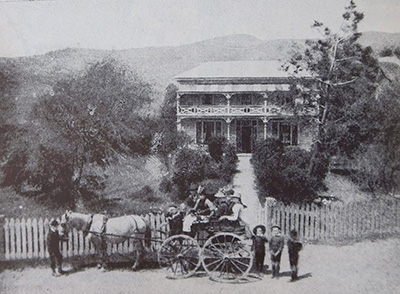
Woodlawn, Bannister family and homestead, at the Halfway (Glenside). Undated.
Photo: Sourced from Carman, A.H. Tawa Flat and the Old Porirua Road (1982, Figure 7).
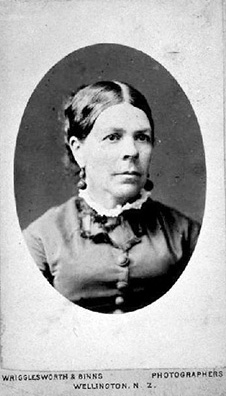
Mary Bannister nee Tutchen. Undated. Photo: Ancestry UK per Ann Foster.
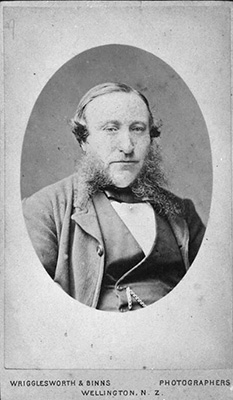
Edwin Bannister. Undated. Photo: Ancestry UK per Ann Foster.
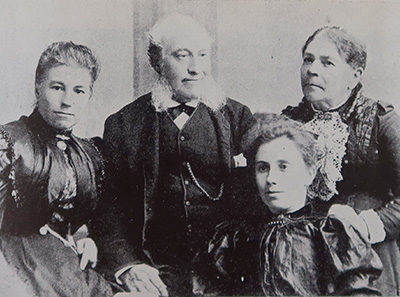
From left: Parthenia, the eldest Bannister child, Edwin and Mary Bannister. Seated, the youngest Bannister child, Emily, also known as Emilie. Undated.
Photo: Sourced from Carman, A.H. Tawa Flat and the Old Porirua Road (1982, Figure 39).
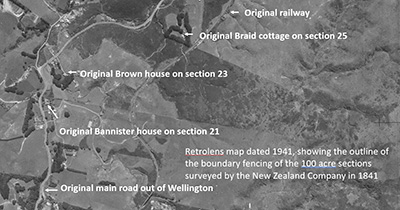
Aerial map overlay dated 1941 showing the location of the former Bannister house, Woodlawn, on its 100 acre section 21 with the railway cutting through their farm. The Browns bought section 23, on which the old Halfway House was situated in c1871 . Both families came to live on their sections at about the same time. In about 1880 the Browns built a new house at the same time the Bannisters enlarged their home by adding a new house onto the front of their original house.
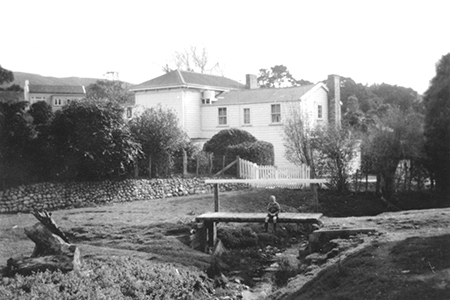
This photograph of Woodlawn was taken when it was owned by the Tulloch family (1930-1963). It shows the former Bannister house with the c1880 addition on front. Photo source: Barbara Tulloch.
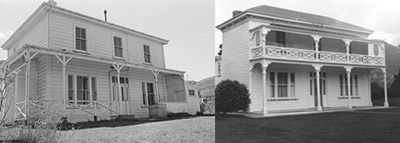
Halfway House in 1973 (left) and Woodlawn, c1960 (right). These photographs help explain why the Woodlawn homestead was often confused as the Halfway House. They look similar.
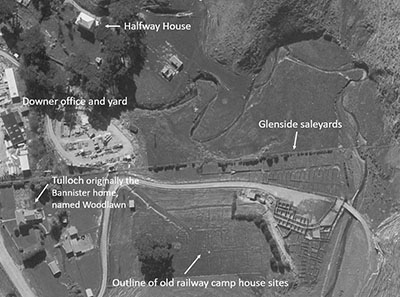
This Retrolens aerial map dated 1961, shows the Bannister house at the time it was owned by the Tulloch family with the Brown house (named Gowan Bank but known as the Halfway House) on the neighbouring section. The close proximity of these houses, their similarity in design and the fact the Bannister family ran an accommodation house, has often resulted in the Bannister house mistakenly called the Halfway House.
Introduction
In the 1870s Edwin & Mary Bannister (nee Tutchen) built a fine large home on Section 21, their 100 acre block on the Porirua Road (Glenside), and named the property Woodlawn, after the rata and totara trees that were growing on the lawn.
On the Bannister's north boundary, across a stream, was the Halfway House, a stagecoach stop on the main road between Wellington and Porirua.
Edwin was a printer by trade, however additional income was provided by Mary offering rooms for accommodation in their spacious Woodlawn home from 1880 to 1889.
The Bannisters had a large family of nine daughters and five sons. Edwin and some of his family are buried at St John Anglican Church in Johnsonville. Their large, magnificent house was burned down in a controlled fire in 1970 and in 2001 the remaining garden trees and shrubs were cut down by the developers of the Monterey apartments.
Edwin's father, William Bannister, and later other Bannister and Tutchen relatives, farmed The Hollies, south of Johnsonville. Today, HollIes Crescent and Bannister Avenue in Johnsonville are named for the Bannister family. The Tutchen heritage lives on in the name Happy Valley (Owhiro) given by Mary's mother for the Tutchen farm, and in Tutchen Avenue, Wellington, where they later lived and farmed their town acre block.
The Early Years
Edwin Bannister was born at Dudley in 1827 and was the son of William Bannister and Mary Eades from Staffordshire, England. The family lived in a place called the 'Old Park'. William was a coal pit owner and iron founder of the firm Bannister, Banks and Company. Incurring heavy losses from the flooding of his mines, William decided to migrate with his family to New Zealand in 1840.
Mary Bannister (nee Tutchen) was born in Devonshire on 16 September 1829. Her parents, Peter and Sarah Tutchen, migrated to New Zealand in 1841.
Both Edwin and Mary’s parents are buried at Bolton St Cemetery.
The Bannister Family Arrive in New Zealand,1840
Edwin Bannister travelled to New Zealand with his parents and his brothers William jnr (19), John Eades (15), and Robert Elijah (9) on the ship Bolton, arriving in April in 1840.
Many of the passengers lived in primitive dwellings known as Boltons Row, until they could build something more substantial. In a letter dated 14 April 1841, William Bannister (senior) writes:
“To our utter astonishment, there was not a house or place to receive either steerage or cabin passengers; so that we were obliged to remain in the ship fourteen days – I mean the women and children. The men, and all the boys that were able went to shore every morning for the purpose of making houses for their future abode, and the lads set to work immediately and erected a little hut just to creep under, and got it done as well as we were able on time.”
About Wellington, William says:
“The only fault I find with this place is its being too mountainous; and the only fault of the weather is too much wind.”
A sentiment Wellingtonians can relate to. The family settled in central Wellington, with William Bannister becoming a licenced publican, establishing the Lambton Tavern. He erected the Crown and Anchor Hotel from 1843 and lived there until 1857, after which he farmed The Hollies, in Johnsonville.
The Tutchen Family Arrive in New Zealand, 1841
Mary Bannister (nee Tutchen) left England, sailing to New Zealand with her parents Peter and Sarah Tutchen and siblings Simon Peter (16), Sarah (14), Charles (13), Josiah (9), Ann (8), Eleanor (6) and David (2).
The 'Guardians of South Petherton', where they lived, gave them four pounds to help them get to London. They departed London on the 3rd June 1841 on the ship Arab, arriving in Wellington on the 16th October 1841.
George Darling’s account, written at the time, describes the sailing as rough and hazardous. There were six births and eight deaths at sea. Mary’s sister Ann died on the journey and was buried at sea. Mary’s account of their arrival was similar to Edwin’s. She says:
“At the time of our arrival there were no houses to be rented, so the families lived on board with the fathers and sons built whares. Ours was situated at Thorndon, near where the brewery now stands. Many people built little homes fronting the sea, along Lambton quay; but about a year after our arrival a fire swept along the water front, and destroyed them. My father took up land at Happy Valley, and after farming it for some years, moved into Wellington and bought a section at Hawthorn Hill, Brougham Street where they remained for the remainder of their lives.”
Happy Valley, originally named by Sarah (Mary’s mother) is better known today as Owhiro. Their home on their section at Brougham Street, Mount Victoria, was named Hawthorn Hill. The farmhouse is still there today, at No 56 Pirie St. Tutchen Avenue is nearby and would have been constructed on what had originally been their town acre farm.
Marriage and life in Wellington before Woodlawn
On the 23rd August 1849, Edwin and Mary were married at St Peters Church Te Aro and settled in upper Cuba Street.
As well as the house they had a shop and dairy. W Tonks brickyard was at the top of the street, and Isaac Lovelock's house adjoined it. Then on the west side were the houses of Lynch, Martin, Edwin & Mary Bannister, J. W. Chisholm, and W. Ashbridge.
Early in his career, Edwin had initially been apprenticed to Mr Revans of the New Zealand Gazette, the first New Zealand newspaper. He later worked on the New Zealand Spectator and Cook Strait Guardian, the Wellington Independent and the Evening Post. Afterwards he joined the staff of the Government Printing office.
He was to remain at the Government Printing Office until retiring to Woodlawn, on the Porirua Road. Many years later. Mr Stan Juleff recalled that Edwin Bannister used to ride into the Goverment Printing Office from Woodlawn on a white horse. Edwin's son Robert Bannister would later become manager of the New Zealand Times and Evening Post.
Having missed out on land sales in the Port Nicholson series, Edwin’s father, William, had initially purchased land in Whanganui. He ultimately sold his interest in Whanganui to Mr Churton, receiving as part of the sale a town acre at the corner of Owen & Constable Streets and a country section. The town acre was sold in 1855 for £18, but the country section on Porirua Road was to become the home of Edwin and Mary, which they named Woodlawn.
In 1871 William Bannister died and it is after this that Edwin and Mary built their home on the country section and moved to live there.
Their house in upper Cuba street was advertised to let in 1875.
Life At Woodlawn (1870s – 1900)
Accommodation
During the 1870s – 1890s Edwin & Mary were managing a working farm at the Halfway (Glenside) and offered rooms for accommodation from 1880 until 1889.
[Ed. In the past, researchers have mistakenly attributed the Halfway House,a travellers inn, to Woodlawn. This could be because the properties were in close proximity, and like the Halfway House, Woodlawn was an accommodation house. Additionally, deliveries and mail to settlers in the locality were addressed to the Halfway House, which is the building where the mail coach stopped and dropped off its deliveries for people to collect. The name Halfway House later became the name for the locality. As a result, people sometimes mistakenly attribute addresses in the locality to the actual Halfway House building].
The Bannister's advertised accommodation in the Evening Post . The first advertisement appeared in 1880. The advertisement ran throughout 6 December 1880 to 8 January 1881.
COUNTRY.—Woodlawn, Porirua Road—Apartments for families or persons. Wedding parties accommodated. Address "Woodlawn," Evening Post office.
In 1883, the Bannister's had two and a half acres of land taken for the railway, which ran through their farm (where the motorway runs today). Surplus stock had to be sold.
WANTED to sell, consequent on destruction of property for railway, a few quiet Cows, calved and to calve. E. Bannister, Woodlawn, or Cuba-street.
Evening Post, 25 June 1883, p.3
It appears that the men constructing the railway may have been accomodated at Woodlawn. In January 1884 the Bannister's advertised a for a good general servant to assist in housework and wait at table and in May 1884 advertised Woodlawn Camp "to let or sell, with appliances, to accommodate for 36 boarders."
This advertisement ran throughout 1 February 1883 to February 1884
COUNTRY.— Woodlawn, near Johnsonville. Rooms at Mrs. E. Bannister's now vacant.
This advertisement ran from 28 to 31 January 1885.
COUNTRY - Rooms vacant at Woodlawn, Johnsonville. Mrs. E. Banniater, or E. Bannister, Cuba-street.
This advertisement ran from 9 to 14 December 1887.
COUNTRY.— Accommodation for Families and Visitors at Woodlawn, Johnsonville. Mrs. Edwin Bannister.
The Christmas season in 1888 offered accomodation and fresh chickens for the festive feast from 15 to 21 December.
COUNTRY. — Rooms and Accommodation at Mrs. Edwin Bannister's, Woodlawn, Johnsonville. Also, this season's Poultry of all kinds supplied on the shortest notice.
Easter Holiday accommodation was advertised on the 17 and 18 April 1889.
EASTER HOLIDAYS.- Accommodation at Mrs. Bannister's, Woodlawn, Johnsonville.
Farm
In 1898 the homestead was described as follows:
“That delightful property known as Woodlawn, situated one mile from Johnsonville Railway Station, consisting of 80 odd acres, with commodious Family Dwelling with every convenience; stable with loft for chaff-cutting; barn, trap-sheds and harness rooms, fowl-houses, yards, &c.; divided into six paddocks; about 10 acres in crop; orchards and kitchen gardens. The whole of the above land is cleared and well fenced.”
Evening Post, 8 October 1898, p.6
The Bannisters farmed cows, turkey, geese and sucking pigs. They also sold poultry, including pure-bred Langshan fowls, Aylesbury and Muscovite ducks, and Guinea fowls (Evening Post, 14 March 1888, p.3). In August 1888 the Poultry Association held a show in Wellington. It was a serious business, with a number of illustrious figures in official roles whose names are very recognisable, including members of the Bannister family. Mary’s contribution to the show is mentioned.
"Upon entering the show one of the first attractions is a venerable specimen of the goose tribe, an old veteran of 27 years of age, according to the legend above the pen. It is shown by Mrs E. Bannister, of Woodlawn, Porirua. Although there is a general suspicion of toughness latent in the wise looking bird, yet he appears to have a large amount of vitality."
New Zealand Times, 3 August 1888, p.5.
In 1889 it was recorded that the farm had 74 sheep, with 61 recorded in 1890. The Bannister's relied on a small number of employees, occasionally advertising for help. Given that Edwin was still working as a printer, the farm would have been very hard work for staff and family.
Tragedy Strikes
In 1885, tragedy would strike the family twice. In April Edwin and Mary’s son-in-law died accidently while out duck shooting at Palmerston North. Later that year their seventh daughter Martha Louisa passed away. Martha was buried at St John Anglican Church, Johnsonville.
Moments with horses
There were a few notable incidents with animals over the years, but one event stands out. On the 10th August 1881 the Evening Post reported:
“A curious accident occurred at Thorndon yesterday afternoon. A horse attached to a cart belonging to Mr. Edwin Bannister, of Porirua, was left unattended in Hill-street, a chain however, being passed through one of the wheels. During the absence of the carter – a man named William Cornwall – the horse bolted along Hill-street. On reaching Molesworth-street, the horse dashed head-long into the shop of Mr. James Godber, confectioner, &c., taking the cart with it. The windows were completely smashed, the counter was damaged and of course great havoc was wrought among the tarts, cakes and other delicacies. The cart was also seriously injured. It is estimated that about £30 or £40 will cover the total damage.”
In March 1888 Edwin had a crash while driving his trap from Johnsonville, presumably to Woodlawn.
“… While driving down the hill the other side of Johnsonville, the wheel came in contact with a large stone and capsized his trap, throwing the occupant out with considerable force, and causing a compound dislocation of the right thumb and several bruises on other parts of the body. The horse and trap escaped with little injury. Mr Bannister was taken to town, and Dr Collins attended successfully to his injuries.”
Evening Post, 5 March 1888, p.2
Oddfellows
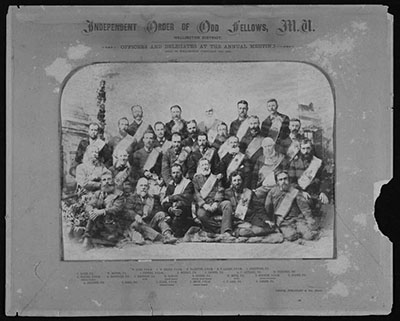
Independent Order of Oddfellows, Manchester Unity, Wellington District. Officers and delegates at the Annual Meeting held in Wellington February 13th 1890 - Photograph taken by Price, O'Malley & Co.Source: Alexander Turnbull Library. Edwin Bannister, second left on the second row.
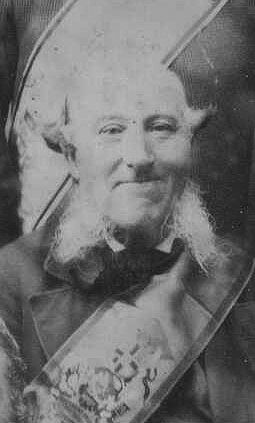
Detail of Edwin Bannister from photograph above, in his Oddfellows livery, 1890.
Edwin was an enthusiastic Oddfellow. Originally a member of the Britannia Lodge, Manchester Unity, he became one of the founders of the Loyal Antipodean Lodge, of which he remained a member. He was Secretary for 40 years and District Corresponding Secretary until his health began to fail.
The Death Of Edwin Bannister
Edwin became seriously ill while visiting his daughter in Palmerston North and passed away in 1895. He was buried in St Johns Anglican Cemetery in Johnsonville with his daughter Martha and son Frederick.
His funeral was a big affair, with a large number of people gathering at Woodlawn and following his body up the “winding tree boarded road to the picturesque Johnsonville cemetery”.(Evening Post, 6 May 1895, p.2)
Especially large was the number of people from the Oddfellows Order who marched before the coffin wearing their insignia of mourning. Among the large procession which followed were many prominent residents with names we recognise today. These included the Mayor of Wellington at the time, Sir Charles Manley Luke, Mr A Warburton (Managing Director New Zealand Times), Mr Blundell, Mr and Mrs H Beauchamp (parents of Katherine Mansfield), H Stebbings and Mr Fitchett among others.
Edwin was buried in the cemetery on top of the hill near the church. Later, the gravestones were removed and this area became a carpark.
The Sale Of Woodlawn
Along with neighbours in the area, Mary had been experiencing issues with trespassers on the property.
Notice to Trespassers. Any persons found Trespassing on Section 21, known as "Woodlawn,” Johnsonville, with dogs or guns will be prosecuted. H. J. Bannister
New Zealand Times, 10 May 1897, p.3
Without the support of Edwin, this may have cemented her decision to sell the homestead and relocate to Palmerston North to be with her family.
The farm was first advertised for the sale by tender in the Evening Post in 1898. Also listed for sale was 5 acres of freehold land situated opposite the Hutt racecourse. Woodlawn was not sold then but later in 1900 it was re-advertised.
Woodlawn was sold to the Juliff (alt. Juleff) family on the 31st October 1900 and Mary moved to Palmerston North. Mary lived there until her death in February 1917 at the age of 87.
The Children Of Mary And Edwin
Mary and Edwin had a large family, nine daughters and five sons. During their lives, Mary and Edwin lost three children Maria (35), Martha (20) and Frederick (10 months). A number of family members later settled in Palmerston North, but records show that the family travelled frequently to and from the Woodlawn homestead and a number of grandchildren were born there.
Parthenia Mary Bannister (1850 – 1927)
Parthenia was Edwin and Mary’s first child. She married Isaac William Lovelock on 16th September 1868. Isaac’s parents had travelled on the ‘Bolton’ at the same time as Edwin and Mary. Isaac later worked with his brother-in-law Mr W Tonks at the latter’s brick works and afterwards assisted in some of the first reclamation work. In 1873, with Mr Pudbey of Petone, he secured the contract for the formation of the main road between Sandon and Carnarvon. Five years later he purchased a farm property on the Rangitikei line. Parthenia died in Palmerston North on 4 January 1927.
Sarah Ann Ellen Bannister (1851 – 1899)
Sarah was born in December 1851. She married Thomas Cooper in 1871 and they lived in Stoney Creek, Palmerston North. They had four children. In 1885 Thomas accidently shot himself while out duck shooting. Sarah died in 1899.
Harriet Matilda Bannister (1853 – 1912)
Harriet married Thomas William Stace in October 1876. They had seven children. Harriet died in Wellington in December 1912, preceding Thomas who died in 1921. Harriet’s grandson Peter Stace Sygrove married Ella Chapman Taylor, daughter of the renowned architect James Walter Chapman-Taylor.
Robert Edwin Bannister (1854 – 1928)
Robert married Mary Ann Eager in 1877; they had three children during their marriage. Robert’s daughter Ethel married Sir Richard Linton, a New Zealand born Australian politician, in 1909 in Wellington. Robert died on 1 September 1928 in Sydney, New South Wales, Australia.
Maria Ann Bannister (1855 – 1891)
On 24th July 1878 Maria married Ludolph Georg West, a Danish architect who later served as fifth Mayor of Palmerston North (1886-1887). They were married at Woodlawn, Ludolph arrived in the Manawatu in 1868, following his brother Henrik, who had come to New Zealand with Bishop Monrad, the former Danish Prime Minister, two years earlier. Maria and Ludolph had seven (surviving) children. Ann Foster is descended from this branch.
Ludolph designed some of Palmerston North's most iconic buildings and houses. Many still stand today, such as Caccia Birch House (briefly the home of Lord Plunkett); the Masonic temple, and the Soldiers' Club on George St.
Maria died suddenly in 1891 and was buried at Terrace End Cemetery, Palmerston North. Ludolph later remarried, and in 1895 named his son Ludolph Edwin Wynn West, in honour of his father-in-law.
Charles William Bannister (1857 – 1941)
Charles married Ann Maria Bartlett at Woodlawn in November 1877 but the marriage was not a happy one. They had two children before they divorced. Charles was a chemist in the employ of the Colonial Sugar Refining company at Fiji. In 1897 he married Edith Kemmis in Sydney and they had one son. Charles died in September 1941 at Chatsworth, New South Wales, Australia.
Josiah Peter Bannister (1858 – 1909)
Josiah was Edwin and Mary’s seventh child and third son. In 1881 he married Frances Emma Collyer and they had three children. Frances died in 1893 and Josiah later married Margaret Coleman; they also had three children.
Jessie Frances Bannister (1860 – 1951)
Jessie was born at Wellington in 1860. In the mid-1870s Jessie moved to ‘Woodlawn’ in Porirua Road with her family. Jessie was still living at Johnsonville in 1896, however by 1900 the electoral roll lists her as ’governess’, living at Fitzherbert, Palmerston North.
In 1893 Jessie signed the Women’s Suffrage Petition. In 1901 she married John Hepworth, a herbalist and widower about twenty years her senior. John died in 1931 and Jessie, childless, in 1951.
Henry John Bannister (1862 – 1947)
In 1907 Henry married Alice Elizabeth Brant and they had one daughter. Henry passed away in Palmerston North on the 7th March 1947.
Eliza Ruth Bannister (1863 – 1916)
Eliza married William Everett in 1895 at the age of 32. William Everett worked as a compositor on the first NZ newspaper “New Zealand Gazette” (established by Samuel Revans), working alongside Edwin who later became his father-in-law. William died in 1902; Eliza died on 3rd March 1916 in Johnsonville at the age of 52.
Martha Louise Bannister (1865 – 1885)
Martha was born in July 1865 and died 14 November 1885 at the young age of 20. She is buried with her parents and brother at St John’s Anglican Church, Johnsonville.
Frederick James Eades Bannister (1866 – 1857)
Frederick was born in September 1866 and died 14th July 1867 aged 10 months. He is buried with his parents and sister at St John’s Anglican Church, Johnsonville.
Jane Elizabeth Bannister (1869 – 1945)
Jane was born in November 1869. She never married and died in March 1945.
Emily Theresa Bannister (1871 – 1938)
Emily (or Emilie), was the youngest child and daughter of Edwin and Mary. In September 1893 she was appointed to the Kaiwhata Aided School but by 1894 the school was urgently advertising for her replacement. She married William Rowlands at St Johns Church, Johnsonville on 27th June 1894. Sadly their only child, Jessie Marguerite died in 1902 at only 5 days old.
Sources
1. The Cyclopedia of New Zealand
2. Letter from William Bannister dated April 14 1841, The New Zealand Journal
3. Wolverhampton Chronicle and Staffordshire Advertiser, 25 August 1841
4. nzetc.victoria.ac.nz
5. ancestry.co.uk
6. Journal of the Early Settler’s and Historical Association of Wellington, Volume 1, Issue 4, 1912/13
7. Carman, Arthur H. Tawa Flat and the Old Porirua Road 1840—1982. The author, Tawa, Revised edition, 1982.
8. nzhistory.govt.nz
9. bdmhistoricalrecords.dia.govt.nz
10. paperspast.natlib.govt.nz
11. Memory Lane: Legacy of architect Ludolph West and his family in plain view, Manawatu Standard, 8 February 2020
12. wairarapaschoolhistory.co.nz/wp-content/uploads/Kaiwhata-Web-Ready-PDF.pdf